
While summer is a great time of year for enjoying the outdoors with your family, it can also bring about some potential health problems for young toddlers. The summer sun, heat, increase in insects and time spent outdoors can lead to various skin conditions for your toddler. In this post, we’ll discuss the 5 most common toddler skin problems during summer and what to do about them.
Sunburn
You may have suspected that this common skin problem would be number one on the list! Researchers have found that young children who are sunburnt will have a greater risk of skin cancer later in life. That highlights how crucial it is to keep your toddler well protected from harmful Ultraviolet A (UVA) and Ultraviolet B (UVB) rays. These harmful rays can also damage your toddler’s eyes so make sure they are wearing a suitable and protective eyewear during the hot summer months.
Some simple tips to keep your toddler safe from UVA and UVB:
- Apply broad spectrum sunscreen to your toddler 30 minutes before they are going to be in the sun
- Avoid going outside in the hottest parts of the day where UV rays are at their highest
- Use protective clothing and hats to keep the sun off your toddler
- Limit exposure to 30 minutes or less
If your toddler is mildly sunburnt, use a cool damp towel on their skin, apply a moisturiser containing aloe vera, give them water and use mild pain relief. If your toddler is extremely sunburnt, take them to a doctor or the hospital.
Molluscum Contagiosum Virus (MSC)
Molluscum contagiosum is a common skin condition in children that many parents are not aware of. For most children it is a temporary condition that will eventually go away, but it can be uncomfortable and unsightly.
The molluscum contagiosum virus thrives in warm and humid environments where people are living in close proximity to one another. It can be spread through any small opening in the skin’s surface. The rash it creates has small bumps which are usually skin coloured, white or pink. These bumps will usually have an indented centre, which makes them somewhat easy to identify.
Most toddlers will get molluscum contagiosum through skin-to-skin contact but it can also be spread by touching objects that have the virus on them, or by swimming in a pool. To prevent your toddler getting the virus:
- Make sure any pool your child goes in is properly chlorinated
- Wash your child off with clean water once they get out of a pool if you are unsure how well chlorinated it is
- Maintain good hygiene, washing your child’s toys/towels regularly
- Don’t let your child play with other children who have a rash that may be molluscum contagiosum
____________
Read More:
Summer Safety Tips for Children in Cars
Safety Tips for Your Family Summer Vacation
7 Things to Know Before Sending Your Child to Summer Camp
____________
Insect Bites
Most insect bites can be a simple nuisance for your toddler, but some can also carry diseases or trigger an allergic response. If you are living in a warm climate, summer will bring an increase in ticks, fleas, mosquitos, bees and many more insects. It is important to keep these insects out of the house and to protect your toddler while they are outdoors. Here are some simple tips for doing so:
- Use insect repellent on your toddler (choose one low in chemicals and safe for use on young children)
- Dress your toddler in long-sleeved cotton shirts and pants. Cotton is ideal because it won’t trap the heat in and will stop most insect from biting your little one.
- Use mosquito nets everywhere. Place them over your child’s crib, on their pram and on their play house. They are cheap and very effective at keeping the insects out.
- Check your toddler for insect bites regularly.
Heat Rash
Perhaps the most common summer skin problem for young toddlers, heat rash is a red or pink rash that occurs when a child is dressed too warmly for the weather. It develops because sweat ducts become blocked and swell. The areas affected can become very itchy and painful.
The simplest way to avoid heat rash is to dress your child appropriately for the weather. Avoid synthetic fabrics and instead buy loose fitting cotton clothes for your child. Cloth nappies are often better than plastic nappies for avoiding heat rash in toddlers. If they do experience some heat rash, use calamine lotion to soothe the area.
Cellulitis
Cellulitis is a skin infection that occurs when bacteria gets into the skin through a cut or abrasion. As the bacteria spreads, it can cause swelling, pain and redness. Certain medical conditions like eczema and acne can increase the risk of cellulitis, because bacteria can enter the skin through the openings caused by those skin disorders.
If your toddler develops cellulitis, they may develop a fever which can be accompanied by chills and sweats. Your toddler will also have a patch of red on their skin where the infection has occurred and possibly swollen lymph nodes. If you suspect your child may have cellulitis, take them to a doctor immediately, they will probably require a course of antibiotics.
The best way to prevent cellulitis is to stop them getting cuts and scrapes — very difficult in summer when they are running around madly. Dressing your toddler in long sleeved clothing can often be enough to prevent a few cuts and abrasions. If you know they will be performing an activity where they could fall over (like riding their tricycle), you can use lightweight kneepads and elbow pads so they avoid cuts if they fall off.
If your child does get a scrape, gently wash the wound with antibacterial soap and apply an appropriate bandage.
{{cta(’29db8acd-fdb8-4abc-a1cc-19662bb6f972′)}}


